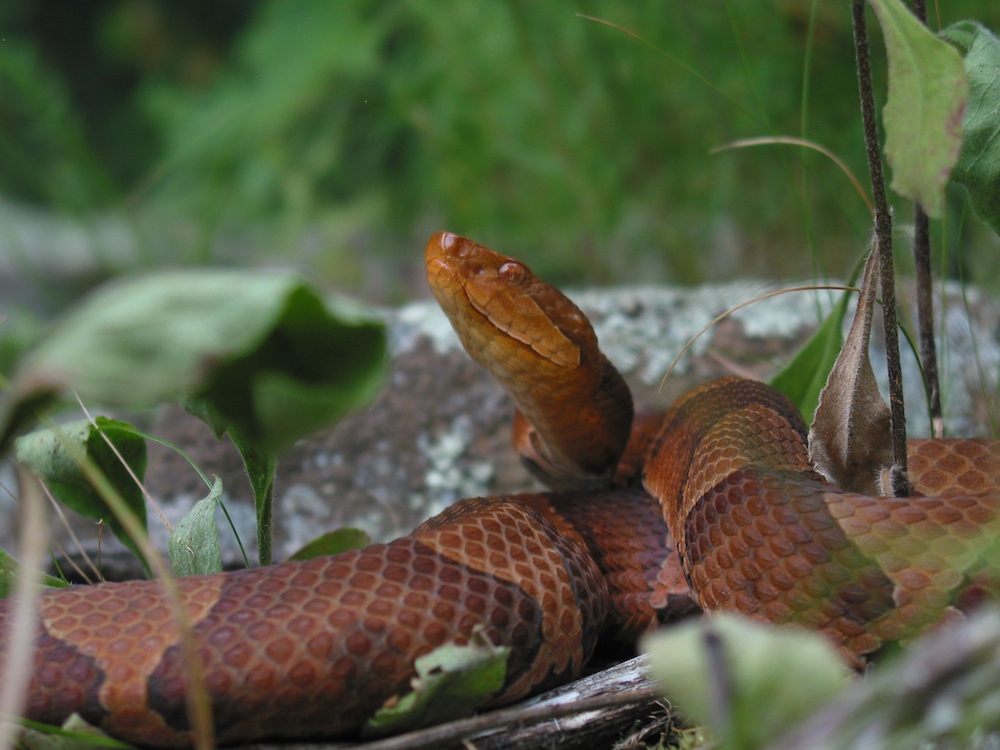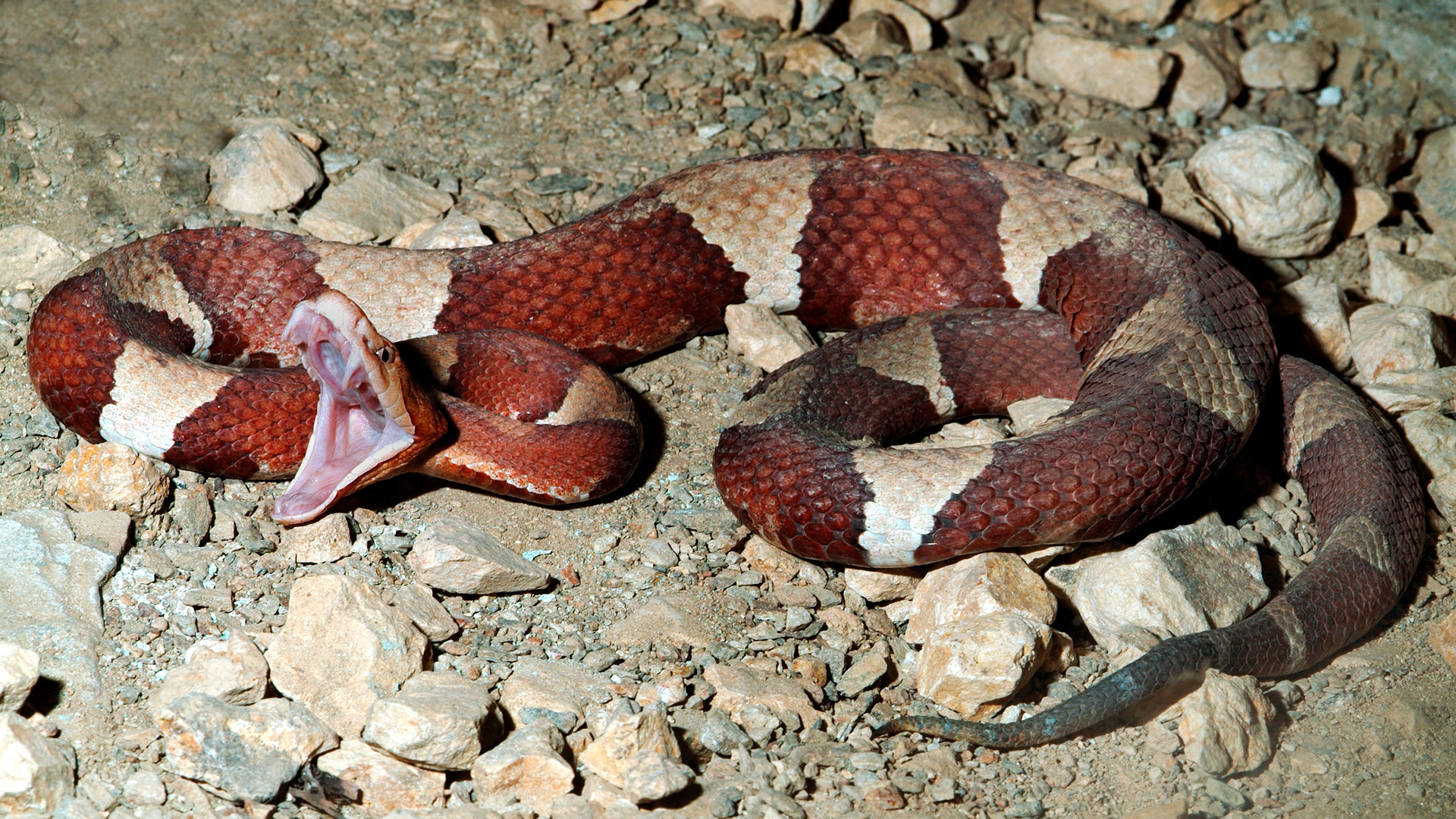Copperhead snakes are some of the more commonly seen North American snakes. They’re also the most likely to bite, although their venom is relatively mild, and their bites are rarely fatal for humans.
These snakes get their name, fittingly, from their copper-red heads, according to the biology department at Pennsylvania State University (opens in new tab). Some other snakes are referred to as copperheads, which is a common (nonscientific) name. Water moccasins (cottonmouths), radiated rat snakes, Australian copperheads and sharp-nosed pit vipers are all sometimes called copperheads, but these are different species from the North American copperhead (Agkistrodon contortrix).
Copperheads are pit vipers, like rattlesnakes and water moccasins. Pit vipers have “heat-sensory pits between eye and nostril on each side of head,” which are able to detect minute differences in temperatures so that the snakes can accurately strike the source of heat, which is often potential prey. Copperhead “behavior is very much like that of most other pit vipers,” said herpetologist Jeff Beane, collections manager of amphibians and reptiles at the North Carolina Museum of Natural Sciences (opens in new tab).
Characteristics
Copperheads are medium-size snakes, averaging between 2 and 3 feet (0.6 to 0.9 meters) in length. According to the Smithsonian National Zoological Park (opens in new tab), female copperheads are longer than males; however, males possess proportionally longer tails.
According to Beane, copperheads’ bodies are distinctly patterned. Their “dorsal pattern is a series of dark, chestnut-brown or reddish-brown crossbands, each shaped like an hourglass, dumbbell or saddlebag … on a background of lighter brown, tan, salmon or pinkish,” Beane said. He further described the saddlebags as “wide on sides of body, narrow in center of back — the crossbands typically have darker margins and lighter lateral centers.” Meanwhile, “some crossbands may be broken, and sometimes small dark spots may be in the spaces between the crossbands.”
Several other nonvenomous species of snakes have similar coloring, and so are frequently confused for copperheads. However, copperheads are the only kind of snakes with hourglass-shaped markings.
In contrast to its patterned body, the snake’s coppery-brown head lacks such adornments, “except for a pair of tiny dark dots usually present on top of the head,” said Beane. He described copperheads’ bellies as “whitish, yellowish or a light brownish, stippled or mottled, with brown, gray or blackish, often large, paired dark spots or smudges along sides of [its] belly.”
Copperheads have muscular, thick bodies and keeled (ridged) scales. Their heads are “somewhat triangular/arrow-shaped and distinct from the neck,” with a “somewhat distinct ridge separating [the] top of head from side snout between eye and nostril,” said Beane. Their pupils are vertical, like cats’ eyes, and their irises are usually orange, tan or reddish-brown.
Young copperheads are more grayish in color than adults and possess “bright yellow or greenish yellow tail tips.” According to Beane, “this color fades in about a year.”
Habitat
Copperheads reside “from southern New England to West Texas and northern Mexico,” said Beane, advising those interested to check out range maps in a number of field guides.

There are five subspecies of copperhead distributed according to geographic range: the northern, northwestern, southern and two southwestern subspecies. According to the Smithsonian National Zoological Park (opens in new tab), the northern copperhead has by far the largest range, from Alabama to Massachusetts and Illinois.
According to Beane, copperheads are happy in “an extremely wide range of habitats,” though usually “at least some semblance of woods or forest habitat is present.” They are “particularly fond of ecotones,” which are transition areas between two ecological communities. They like rocky, wooded areas, mountains, thickets near streams, desert oases, canyons and other natural environments, according to Penn State; Beane added that they like “almost any habitat with both sunlight and cover.”
According to the Savannah River Ecology Laboratory (opens in new tab), copperheads are “quite tolerant of habitat alteration.” This means that they can survive well in suburban areas. Copperheads can sometimes be found in wood and sawdust piles, abandoned farm buildings, junkyards and old construction areas. They “often seek shelter under surface cover such as boards, sheet metal, logs or large flat rocks,” said Beane.
Behaviour
Copperheads are semi-social snakes. While they usually hunt alone, they usually hibernate in communal dens and often return to the same den every year. Beane said that populations in the “montane” (a forest area below the timberline with large, coniferous trees) often spend the winter hibernating “with timber rattlesnakes, rat snakes or other species.” However, “Piedmont and Coastal Plain snakes are more likely to hibernate individually,” Beane said.They also can be seen near one another while basking in the sun, drinking, eating and courting, according to the Smithsonian Zoo.
According to the Ohio Public Library Information Network (opens in new tab), copperheads are usually out and about during the day in the spring and fall, but during the summer they become nocturnal. They especially like being out on humid, warm nights after rain. While they usually stay on the ground, copperheads will sometimes climb into low bushes or trees in search of prey or to bask in the sun. Sometimes, they even voluntarily go swimming.
According to Animal Diversity Web (opens in new tab) (ADW), a database maintained by the University of Michigan Museum of Zoology, scientists have hypothesized that copperheads migrate late in the spring to their summer feeding area, then return home in early fall.
Diet
He described copperheads as being “mobile ambush predators.” Mostly, they get their prey by “sit-and-wait ambush”; however, they sometimes do hunt, using their heat-sensing pits to find prey.
The ADW explains that when attacking large prey, copperheads bite the victim, and then release it. They let the venom work, and then track down the prey once it has died. The snakes usually hold smaller prey in their mouths until the victim dies. Copperheads eat their food whole, using their flexibly hinged jaws to swallow the meal. According to Penn State, adult copperheads may eat only 10 or 12 meals per year, depending on the size of their dinners.
Reproduction
Copperhead mating season lasts from February to May and from late August to October, and it can be a dramatic affair. “Males may engage in ritual combat (body-shoving contests) when two or more meet in the presence of a receptive female,” said Beane. According to Penn State, the snakes that lose rarely challenge again. A female may also fight prospective partners, and will always reject males who back down from a fight with her.

Copperheads are ovoviviparous, which means that eggs incubate inside the mother’s body. Babies are born live. After mating in the spring, females will give birth to “from two to 18 live young in late summer or fall,” said Beane. According to The Maryland Zoo (opens in new tab), after mating in the fall, the female will store sperm and defer fertilization for months, until she has finished hibernating. Baby copperheads are born with fangs and venom as potent as an adult’s, according to the Smithsonian Zoo.
Young copperheads are 8 to 10 inches (20 to 25 cm) long and are born with both fangs and venom, according to Penn State. They eat mostly insects, especially caterpillars.
Beane pointed out that young copperheads may exhibit different hunting patterns than adults. “Young snakes may sit otherwise motionless, flicking their yellow tail tips,” he said. “This is known as ‘caudal luring’; the tail resembles a small caterpillar or other insect and may attract a lizard or frog [to come] within striking range.”
Classification and taxonomy
According to the Integrated Taxonomic Information System (opens in new tab) (ITIS), the taxonomy of copperheads is:
Kingdom: Animalia Subkingdom: Bilateria Infrakingdom: Deuterostomia Phylum: Chordata Subphylum: Vertebrata Infraphylum: Gnathostomata Superclass: Tetrapoda Class: Reptilia Order: Squamata Suborder: Serpentes Infraorder: Alethinophidia Family: Viperidae Subfamily: Crotalinae Genus & species: Agkistrodon contortrix Subspecies:
- Agkistrodon contortrix contortrix (Southern copperhead),
- Agkistrodon contortrix laticinctus (broad-banded copperhead),
- Agkistrodon contortrix mokasen (Northern copperhead),
- Agkistrodon contortrix phaeogaster (Osage copperhead)
- Agkistrodon contortrix pictigaster (trans-Pecos copperhead)
Bite
Copperheads bite more people in most years than any other U.S. species of snake, according to the North Carolina State University Cooperative Extension Service (opens in new tab). Fortunately, copperhead venom is not very potent.

(opens in new tab)
Unlike most venomous snakes, copperheads give no warning signs and strike almost immediately if they feel threatened. Copperheads have hemotoxic venom, said Beane, which means that a copperhead bite “often results in temporary tissue damage in the immediate area of bite.” Their bite may be painful but is “very rarely (almost never) fatal to humans.” Children, the elderly and people with compromised immune systems may have strong reactions to the venom, however, and anyone who is bitten by a copperhead should seek medical attention.
Despite this, Beane thinks you should still let a Copperhead snake live in your back yard. He told North Carolina’s Blue Ridge Public Radio (opens in new tab) that, “if you encounter them and they’re coiled up somewhere where they want to be, they’ll remain completely still and hope that you don’t see them or bother them… If you do disturb them, the first thing they’ll probably do is try to get away. If you move them… they’re going to try to get back to something that’s familiar.”
Bean also talked about the benefits of having a Copperhead near your house: “They eat a lot of species that we don’t like, like mice and rats, that can cause diseases and problems. And [by] eating a lot of rodents, snakes are swallowing a lot of ticks. And ticks cause things like Rocky Mountain spotted fever and Lyme disease. One study showed that snakes are significant tick destroyers in Eastern forest sites.”
Research
According to recent research on the US National Library of Medicine (opens in new tab), snake venom in general is “recognized as a potential resource of biologically active compounds” that can be used in cancer treatments. Scientists have found that a chemical in copperhead venom may be helpful in stopping the growth of cancerous tumors. Researchers at the University of Southern California injected the protein contortrostatin from the southern copperhead’s venom, directly into the mammary glands of mice where human breast cancer cells had been injected two weeks earlier.
The injection of the protein inhibited the growth of the tumor and also slowed the growth of blood vessels that supply the tumor with nutrients. The venom’s protein also impaired the spread of the tumor to the lungs, one site where breast cancer spreads effectively.
Other facts
- The length of a copperhead’s fangs is related to the length of the snake — the longer the snake, the longer the fangs.
- When touched, copperheads sometimes emit a musk that smells like cucumbers.
- The penny is sometimes called a copperhead.
- Northern Democrats who opposed the U.S. Civil War were called Copperheads, according to the Journal of the Abraham Lincoln Association (opens in new tab).
Additional resources
How dangerous are copperheads? The Cooperative Extension Service at North Carolina State University puts it simply: “Avoid Copperhead snakes! (opens in new tab)” Learn more about copperheads on the Animal Diversity Web (opens in new tab). Check out the Smithsonian Zoo’s detailed fact sheet about copperheads (opens in new tab).
Originally published on Live Science Dec. 16, 2021 and updated July 31, 2022.
Stay connected with us on social media platform for instant update click here to join our Twitter, & Facebook
We are now on Telegram. Click here to join our channel (@TechiUpdate) and stay updated with the latest Technology headlines.
For all the latest For Top Stories News Click Here
